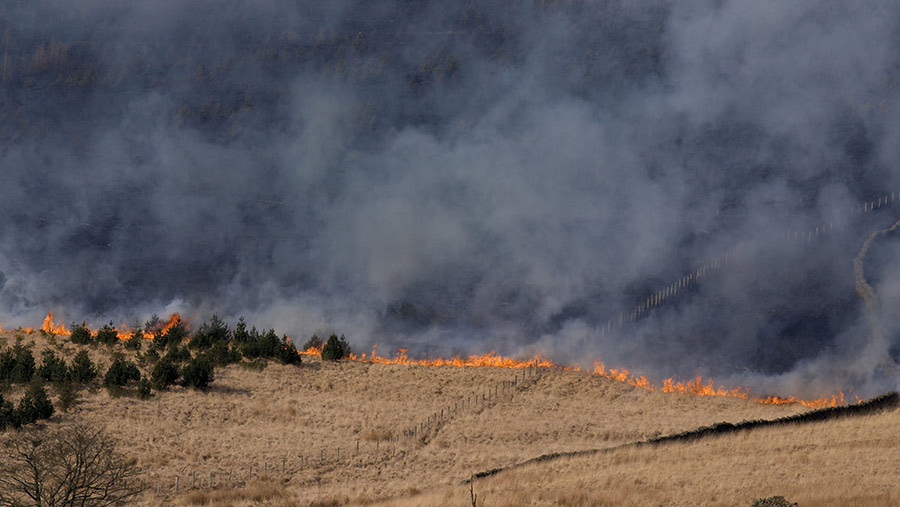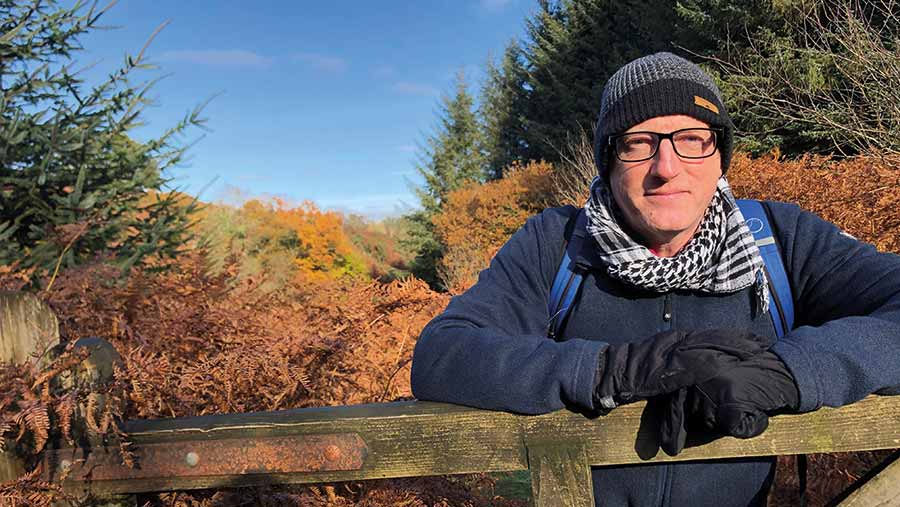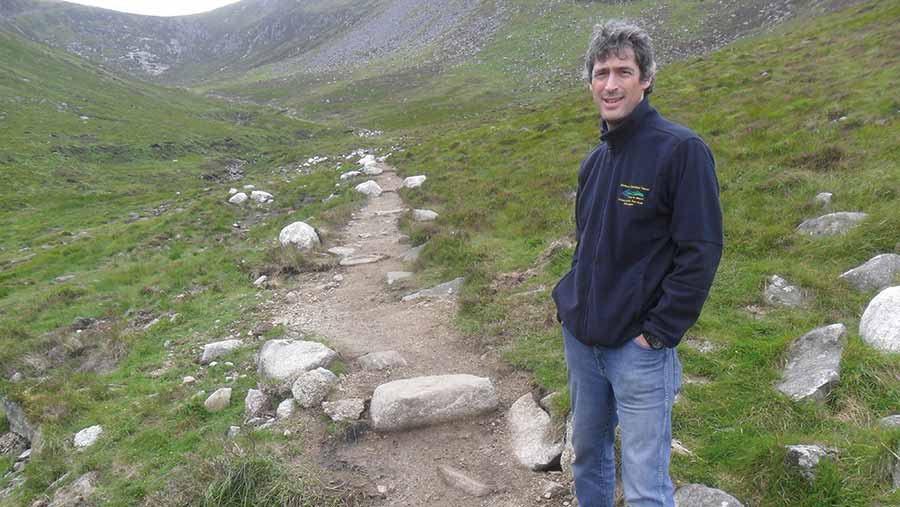Pros and cons of controlled moorland fires

With the grouse shooting season under way from 12 August and the country gripped by another heatwave, questions have been raised about the role of controlled burns in the uplands.
The Wildlife Trusts argue that a ban is long overdue. “It is devastating to the climate and to nature,” says its director of landscape recovery, Dr Rob Stoneman – a view that is endorsed by both Greenpeace and Wildlife & Countryside Link.
See also: Fire crews tackle field blazes amid July heatwave
For controlled burning
But Henrietta Appleton, a member of the policy team at the Game & Wildlife Conservation Trust (GWCT), says managed vegetation burning is necessary to reduce the potential wildfire fuel load.
She suggests it is the association with grouse shooting that clouds its value as a fire mitigation measure, as vegetation management for farmed livestock and red grouse, and for conservation purposes.
According to Ms Appleton, large areas of the uplands where grouse management has been abandoned now have a “huge build-up” of fuel load, risking potentially catastrophic fires burning deep into the peat.
This risk is increasing due to climate change which is resulting in hotter, drier summers and milder, wetter winters, encouraging more vegetation growth.
This summer, for the first time, swaths of moorland in England’s National Parks have been shut to the public because of wildfire risk.
The Moorland Association has therefore called for a major rethink on how best to tackle these risks, including controlled heather burning – a practice it insists is supported by fire and rescue services.
Its chairman, Mark Cunliffe-Lister, says controlled burning can be a “massive help” in tackling wildfire threats.
“There needs to be a collective rethink about this, rather than continuing pressure being placed on ministers for further restriction or banning of vegetation management by burning in the uplands,” he says.
Conversely, the Wildlife Trusts maintain that the best fire prevention method is to block ditches and help the peat become wet again.
Complex issue
In England, controlled burning is guided by a Heather and Grass Burning Code endorsed by Defra, Natural England and sector bodies, with licences required for controlled burning on protected sites over deep peat and consent required on sites of special scientific interest.
The possible effects on water quality, flood risk and carbon storage from heather burning, especially over blanket bog, is a complex issue with a range of findings and interpretations.
The GWCT, which has recently published a science-based report on the ecosystem services provided by this and other grouse management interventions, says the role of fire in moorland management has triggered “inevitable differences of opinion”.
“There are many reasons for this, including the interplay of different factors, and the complexity and variety of habitats under consideration,” it says.
Against controlled burning
Yet Dr Stoneman of the Wildlife Trusts says the need for a total ban is clear, arguing that moorland burning creates heather “monocultures”, and pointing to the Yorkshire Dales. He believes it actually increases fire risk, not reduces it.
Dr Stoneman also blames the practice for declining salmon and trout populations in certain rivers, through water pollution.

Rob Stoneman © The Wildlife Trusts
He is sceptical about why multiple arguments against the practice have not resulted in it being outlawed.
“Many politicians are grouse shooters and they have a very effective lobby,’’ he says.
Dr Stoneman argues that the practice is already illegal under habitat, bird and water framework directives, and that the law of nuisance applies too. “We want to see our current laws enforced properly,” he says.
Water quality
But the GWCT says any possible effect burning has on water quality and run-off is complicated by interactions with other upland management measures, such as woodland expansion and grazing.
“There is evidence that in England, burning may be associated with increased water colour, with some sources equating this to an increase in dissolved organic carbon (DOC) in the water,” it says.
“However, one study showed that DOC did not rise in response to burning, and the colour of water is not always a good indicator of DOC. Another showed that DOC in the nearby lake fell following a wildfire. The picture is not clear.”
The numbers and diversity of species that live in an area are influenced by controlled burning, but the GWCT suggests some species are more abundant where there is burning, including curlew.
The golden plover prefers to nest in areas of short vegetation typical of sites where burning has recently occurred, it adds.
What exactly does moorland burning involve?
Prescribed heather burning refers to setting a fire on moorland, following specific codes of practice.
Typically it involves planned burns of small patches of older heather – in some settings around 30m x 30m, but sometimes larger – to remove the heather and grass canopy without damaging the underlying peat or soil layer.
The process of burning small areas in rotation removes the older growth and allows the plants to regenerate as feed for red grouse, deer, mountain hares and farmed livestock.
Burning small areas of heather in different years leads to a patchwork, with heather and other vegetation of different ages and heights.
Grouse moors typically maintain a burning plan that identifies which areas to burn in which years, as well as sensitive and no-burn areas.
The law allows burning to be carried out only between October and mid-April in most of the UK, but the cut-off point is earlier (at the end of March) in Wales.
Most burning occurs in the spring when the plant material has dried out, allowing it to burn, while cold, damp conditions underfoot mean the fire is more easily controlled.
Burns are not performed in summer because birds and other animals are breeding, the daily temperatures are warm, and underlying peat may be drier.
Case study: Fighting fire with fire in the Mourne Mountains
Prescribed burning was introduced in the Eastern Mourne Mountains in County Down after devastating wildfires.
Heather, gorse and grass-clad slopes grazed by mountain sheep were once not as susceptible to wildfire because of wetter conditions, but in April 2011, a dry period and an easterly wind pushed a blaze across the Eastern Mourne Mountains, burning 1,000ha in an area designated for its upland habitat.
This inspired the development of a pilot wildfire project covering 7,000ha.

Matthew Bushby © Matthew Bushby
A report published in 2012 concluded that, along with developing a site wildfire plan and enhancing emergency response capacity, the most effective approach would be to carry out land management including prescribed burns in areas identified as “gateways”.
By reducing the fuel load in these areas, it would slow down a blaze and give firefighters a chance to control it, the report advised.
It also recommended the use of “operational burns” as an advanced tactic during a wildfire.
The Mourne Wildfire Group was established to deliver this project, with Mourne Heritage Trust countryside service manager Matthew Bushby as its chairman.
A significant part of the project was to trial how prescribed burns could be used specifically for fuel management to help mitigate wildfire damage and in firefighting.
The “cool burns” take off the surface vegetation rather than burn into the peat, and take place in March when dry conditions are more likely.
Drip torches with a mix of petrol and diesel are used to light the designated area, and generator-driven water pumps and backpack sprayers help suppress the flames.
One risk of burning is that it can negatively change the vegetation – molinia grass can dominate, for example – but this project found that, if carefully managed, livestock can be used to preserve the original plant populations.
Mr Bushby said there had been concern that prescribed burning would put habitat into an unfavourable state, but this has not been evidenced.
“We’ve done it in a carefully planned way, avoiding the negative impacts,” he said.
